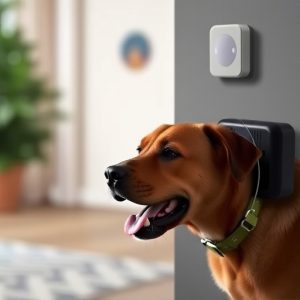Wireless Alarm Systems: Motion Sensors, Barking Dog Alarms, and Tips for Installation
Wireless alarm systems, featuring motion sensor barking dog alarms, revolutionize home security with…….
Wireless alarm systems, featuring motion sensor barking dog alarms, revolutionize home security with flexible, customizable solutions. These devices combine motion detection with realistic dog barking simulations to deter intruders, offering a safe alternative to traditional alarms for pet owners and large dog households. Easy installation, strategic sensor placement, and remote control make wireless systems a popular choice for robust yet simple security measures in homes with open spaces or high traffic areas. Regular maintenance ensures optimal performance, allowing homeowners to customize settings and stay protected.
“Uncover the power of wireless alarm systems, a modern solution revolutionizing home security. This comprehensive guide explores innovative technologies, with a focus on motion sensors and their pivotal role in detecting intruders. We delve into an intriguing aspect: integrating a barking dog alarm, offering both entertainment and enhanced security. Additionally, learn installation secrets for a robust system that provides peace of mind. From understanding the basics to practical tips, this article covers all you need to know about wireless alarm systems, motion sensors, and innovative dog alarm solutions.”
Understanding Wireless Alarm Systems: A Brief Overview
Wireless alarm systems have revolutionized home security, offering a modern and flexible solution compared to traditional wired setups. These systems operate by utilizing various sensors, such as motion detectors, to trigger alarms when unauthorized access is attempted. One innovative device that has gained popularity is the motion sensor barking dog alarm. This gadget combines the capabilities of a motion sensor with a realistic dog barking simulation, scaring off potential intruders and providing an extra layer of protection for your home.
The beauty of wireless systems lies in their ease of installation and customization. Components can be strategically placed throughout a property, ensuring comprehensive coverage without the hassle of running wires. For example, motion sensors can be installed near entry points, windows, or valuable asset areas, allowing homeowners to tailor their security measures precisely to their needs. This adaptability is especially beneficial for those with pets, as specific sensors can differentiate between actual intruders and furry family members, preventing false alarms while maintaining optimal security.
The Role of Motion Sensors in Security
Motion sensors play a pivotal role in modern security systems, offering advanced protection against unauthorized access. These innovative devices detect movement within a specified range, triggering alarms and alerting homeowners or security personnel instantly. One notable example is the motion sensor barking dog alarm, designed to mimic the natural reaction of a protective dog. When an intruder enters the surveillance zone, the sensor activates, emitting loud barks that deter potential threats.
The integration of motion sensors enhances security measures by providing a proactive approach to home protection. Unlike traditional alarms that rely solely on breaking glass or opening doors, motion sensors detect any unusual activity, ensuring a faster response time. This technology is particularly effective in areas with high foot traffic or open spaces, where it can effectively guard against break-ins without the need for extensive wiring or complex installation processes, making it a versatile and efficient security solution.
Integrating a Barking Dog Alarm: Benefits and Functionality
Integrating a barking dog alarm into your wireless security system can be an innovative way to enhance home protection. This type of alarm leverages motion sensors and a dog’s innate barking behavior to deter potential intruders. The primary benefit lies in its ability to provide an extra layer of defense, especially for pet owners or those with large dogs that can be trained to respond to specific commands. When a motion sensor detects unusual activity, the alarm triggers a high-decibel bark, startling and scaring off intruders without causing harm.
Functionally, these alarms are designed to be user-friendly and customizable. Homeowners can set sensitivity levels to avoid false alerts triggered by small animals or pets. Some models even offer remote control features, allowing users to silence the alarm or arm/disarm the system from a distance. This technology is particularly useful for properties with large yards or open spaces where traditional alarms might not be as effective.
Installation and Maintenance Tips for a Reliable System
Installing a wireless alarm system, complete with a motion sensor and barking dog alarm, is a straightforward process that can be completed by most homeowners. Begin by selecting a system that suits your needs and preferences, considering factors like range, sensitivity, and number of sensors. Place the central control panel in a prominent, easily accessible location, typically near an entrance or in a central living area. Mount the motion sensors at strategic points around your property, ensuring they have line-of-sight to cover all potential entry points.
Regular maintenance is crucial for reliable operation. Test each sensor monthly to ensure it triggers correctly and clean any debris from their lenses. Check the backup battery power of the control panel periodically, replacing as needed. Familiarize yourself with the system’s settings and programming, allowing you to customize response actions and sensitivity levels. Keep your system updated with firmware patches when available, enhancing its performance and security.


